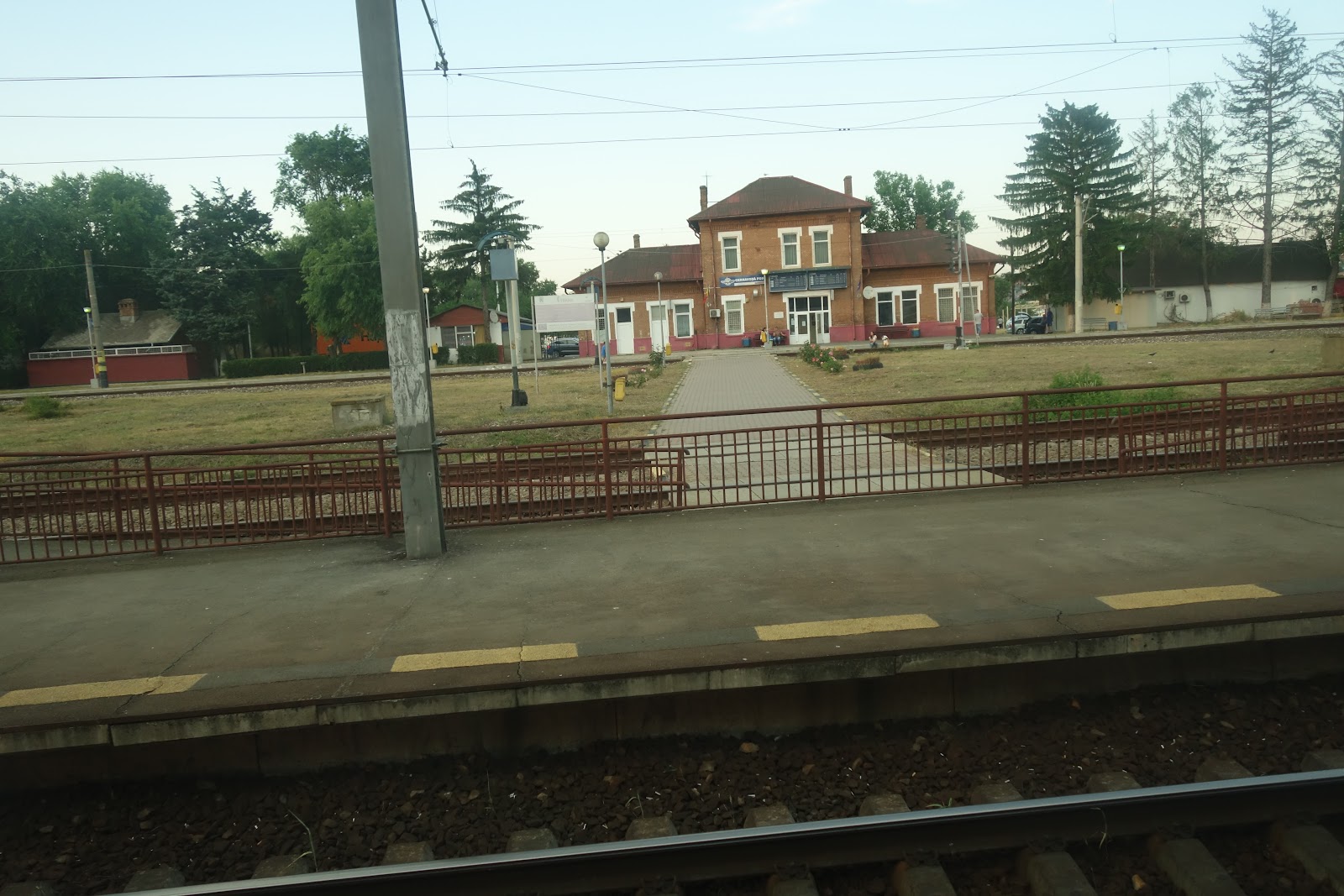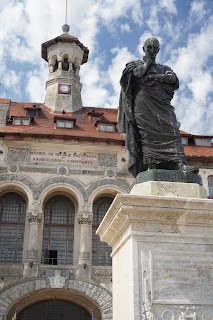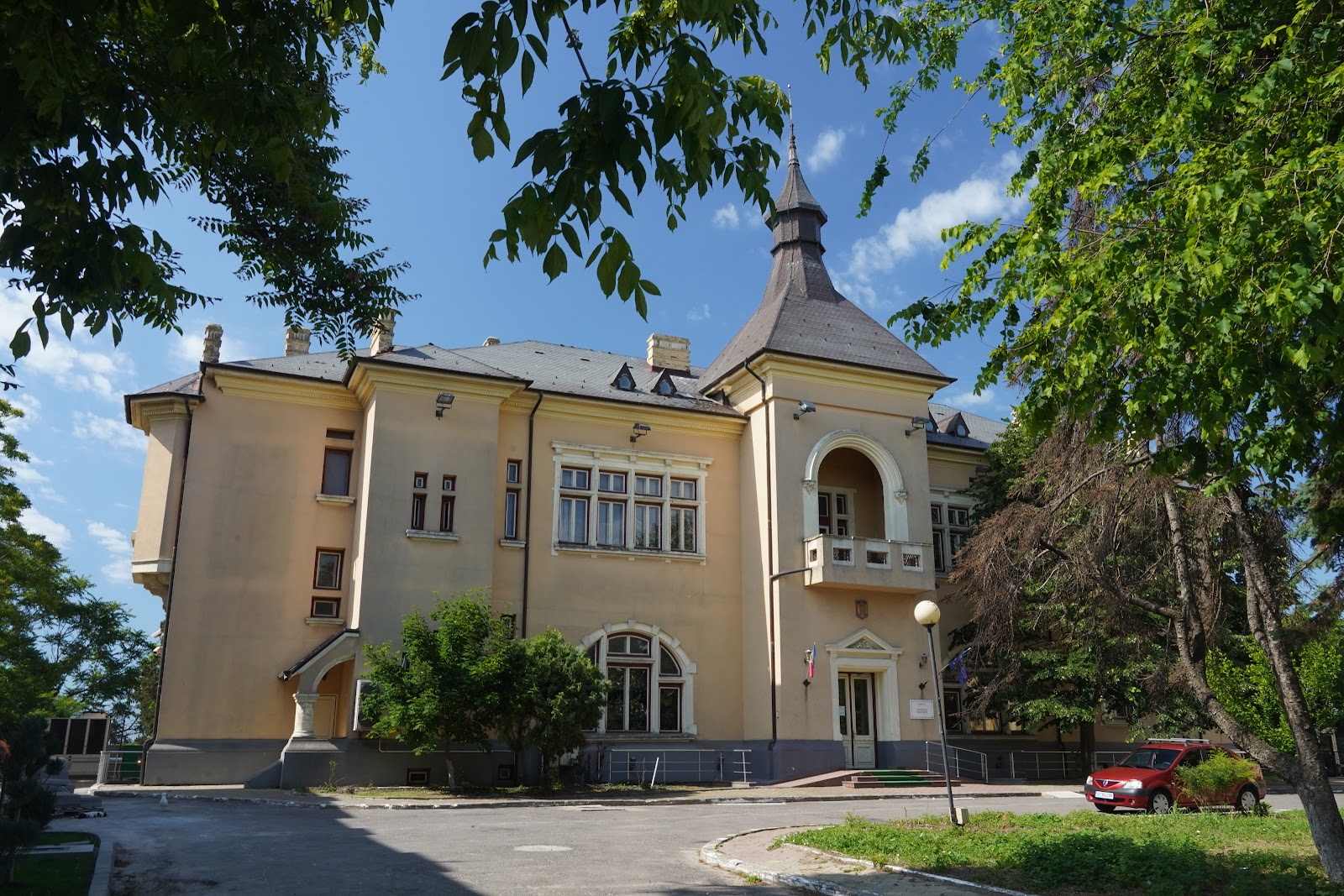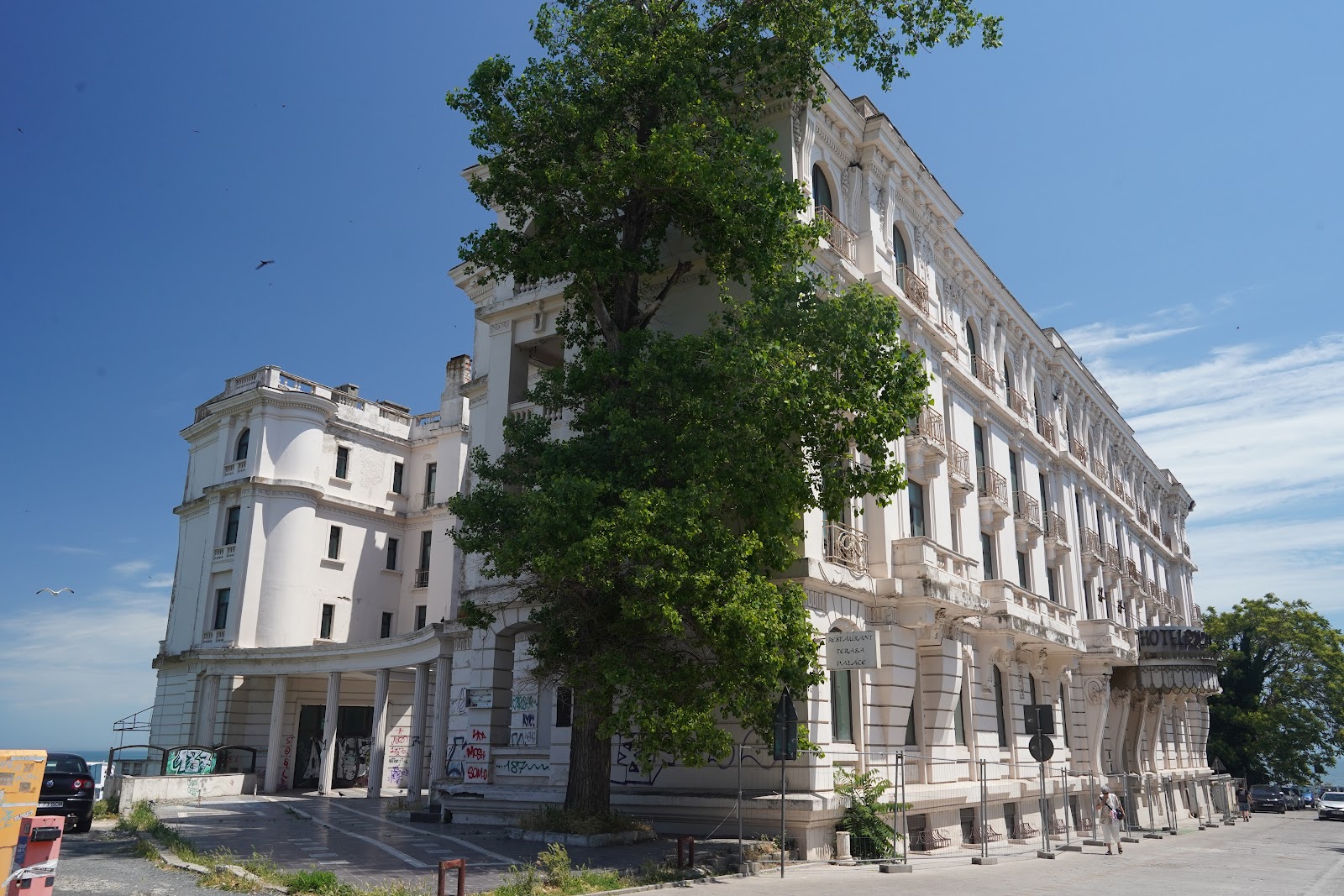The eastern-most point of the EU
The easternmost place to reach by train in the EU states is Constanta in Romania. Although you might by able to get as far east in Finland. Constanta is the 5th biggest port in the EU after Rotterdam, Antwerp, Hamburg and Algeciras. At the moment its role has increased even more since it is the most important port for save shipping to and from Ukraine. It is also one of the oldest cities in Europe. And it is a cultural melting pot: Romans, Byzantine, Bulgarian, Ottoman, Germans and Romanians formed it.
View of the old town of Constanta
There is a direct train from Brasov to Constanta via Bucuresti. It needs a seat reservation and I managed to get one in Sighisoara. When I board train 347 from Vienna to Bucuresti at 12.25 in Sighisoara, I will arrive in Constanta at 11 pm after waiting almost 2 hours in Brasov for the connection. Train 347 also continues to Bucuresti, but it was fully booked after Brasov.
Train 347 is a night train and they are almost always late. However, surprisingly enough it arrives in Sighisoara almost on time. For the about 120 km from Sighisoara to Brasov it takes 3 h 15 min. The reason is the EU. Somebody had the idea that Europe needs a rail corridor linking the important ports of Constanta at the black sea and Gdansk in Poland at the Baltic sea. In Romania, they are basically building an entirely new railway line from the Hungarian border to Brasov. All the old bridges are renewed, in part the line runs on a different, new bed with new tunnels and long, new bridges crossing whole valleys. They were already busy with that when I was here last time in summer 2021, three years ago. But the progress is very slow. For example, they had completely torn open the last part before Brasov in 2021 but it is still not finished.
Handing over the train orders
Strangely enough they seem to work everywhere at the same time. When the old line is renewed on the original bed they remove one track and catenary. However, in many sections, works don’t start after that second track is removed. There and where they built a parallel, completely new, railway the remaining old track is not longer maintained, which means the train can only pass very slow.
The ghost train to Sibiu in Sighisoara
I remember the station in Sighisoara from when we passed through 3 years ago. It was a mess. Now they have brandnew platforms with underpasses. The huge station building is well integrated in the new layout with the high platforms. However, there are no elevators. People who were used to pull their trolleys, bicycles or baskets across the tracks have to use stairs now. Some still just cross the tracks, but because of the height of the platforms it is difficult to get down and up again. And most of that modern stuff the EU has given to Romania, like the electronic train announcement displays, do not work.
Road crossing and stork's nest
And now I have the evidence. There are ghost trains in Romania. When I arrive there is a train ready to depart. The displays don’t work, there is no display on the train, and in the written schedule in the station hall there are no trains announced at that time at all. There is also no train in the interrail timetable. When I ask somebody they tell me that it goes to Sibiu. I wanted to se Sibiu but did not go there because I did not see any suitable train connections in the timetable.
Regardless the works train 347 is on time but it is incredibly slow. In some parts it does not ride faster than a cyclist. The engine frequently blows the horn, probably to warn or wake up workers on the line. Indeed I see some sleeping at the construction sites. But it also is very warm.
What does not change is the countryside, the villages and the people who now have to deal with this new arrival from outer space. Little villages of mud-colored brown houses with red roofs overtopped by both a traditional Saxon church with pointed steeple and orthodox church with cupola. The perfectionist vegetable gardens behind the little brown houses. There are still farmers with horse carts where the horse pulls home its own fodder. Storks have built enormous nests on some of the electricity or telephone poles. The heads of the young ones, already quite big, look expectantly in the direction from where to await a parent with food.
One of the many industrial ruins along the line
The train is next to empty. When the conductor comes to check my ticket he does not ask for any reservation. I check the schedule. If train 347 also arrives on time in Bucuresti, I would be able to get a connection which brings me to Constanta two hours earlier. However, for this alternative I do not have a reservation. Anyway, it is worth a try. I don’t get off the train in Brasov to wait for the later train, for which I have a reservation, but stay.
After Brasov the train climbs into the mountains. The stations of Predeal, Azuga, Busteni and Sinaia all belong to mountain resorts, some even give access to a cable car and ski areas. Suddenly, while the train winds slowly up the curves to the stop in Predeal, there is a hellish noise in the carriage. It is the combined noise of all the mobile phones. A RO alert is issued. They warn of a bear which is walking down Nicolae Balcescu street. They advice to get away and stay inside. Don’t take pictures. When the train stops in Predeal there is no bear but crowds of children. Now the train indeed gets very full. It turns out that it is childrens’ day and many mothers or school teachers have felt the obligation to do something what they think is nice for the little ones. For example ride in a hot and full train. I flee to the carriage with the bar, but it also fills with the next stops. When the conductor comes for checking the tickets there are no free seats left. He checks my ticket and gives me a friendly smile because he remembers me. He does not ask for a reservation. By the way, no coffee in the bar.
In this section the train passes through a fabulous mountain scenery. To the right a cable car climbs up to the summits high above the town of Sinaia. It is an old resort town. I have been there 3 years ago. The bears come at night and pillage the waste bins of the hotel, they say. However, I did not see any. The first king Carol of Romania built a castle there. I previously have written a blog entry about this lovely place:
The journey gets particularly slow the last kilometers before Bucuresti Nord station. I have 20 min to get to the other train, but the available time melts away. Eventually I shoulder my backpack and make my way to the doors. We are not at the station yet but somebody has already opened one. So after we finally arrive I get out as one of the first and look around for the platform of the departing train to Constanta. In Romania there is no announcement in the train or on the platform to inform about correspondences.
Eventually I find it and the train is full. I just sit down at one of the free seats, but in the last moment before departure a couple comes and claims it. I change to another. Soon the conductor comes to check the tickets. It takes some time to load the interrail ticket on the phone and the guy seems to be in a hurry, so does not even check mine. At the first stop after Bucuresti a woman with a lot of bags comes in and it turns out that I sit on her seat. However, she does not care. She spots another free spot and sits down there. Another sign of the Romanian friendliness and helpfulness.
The line from Bucuresti to Constanta is basically straight and the train runs at a considerable speed. It is hot. The air conditioning is absolutely insufficient. Fortunately the girl next to me unpacks a fan and that is also some relief for me.
Before arrival in Constanta the train crosses several arms of the Danube on spectacular bridges. There is also a big, Soviet era nuclear power plant, which strangely enough does not have cooling towers. Probably they use the river water and pump it back in as it is. The guy sitting opposite assures me that the plant is still in use. A friend of his works there.
It is dark when I arrive at Constanta on time at 21.02. It is a 10 min walk to a hotel I have booked. The girl at the reception recommends a restaurant which is open 24/7 and only a 10 min walk away.
At night the area is a bit strange. Ugly style-free buildings of different heights, workshops and lots of car-washes. In between a flower stand which even is still open when I walk back after 11 pm. Expensive cars park on the sidewalk. A bar or club where men in black suits and women in tight, short and fashionable dresses smoke a cigarette in front of the door. Inside I see tables with table clothes, lots of glasses and bottles and people dancing.
When I come to the recommended restaurant they send me upstairs. It is quite busy for the time, almost 10 pm. On numerous screens they broadcast soccer at high voice. To make it even more impressive they also have turned the background lounge music just hard enough to feel the bass.
The service is slow but it turns out that they have German wheat beer. The food is also OK. But the noise is unbearable. I regret I do not have those noise canceling headphones everybody uses nowadays. And they have a point. It turns out that it is the Championship final between Borussia Dortmund and Real Madrid. When I leave they just have restarted after the intermission and there was no goal yet. It is clear that the locals are in favor of the team of Germany’s ugliest town. Maybe they have pity. Eventually money wins since I hear later that Dortmund lost 0:2.
The next morning I walk into town along a dusty, busy and hot main road. Next to an intersection there is a big fountain. It is dry. A guard watches the turkish consulate. Then I find a pedestrian zone. Most of the beautiful old buildings are empty. When not they house an amazing number of money changers, outlet shops, second hand stores and fast food restaurants. The pedestrian zone is next to deserted. Eventually I realize that it is a Sunday. Most of the shops are closed and that might explain the emptiness.
Constanta already was a port and trading post even before the Romans arrived. Legend has it that Jason and the argonauts landed here after stealing the Golden Fleece. Fact is that evidence of habitation goes back to 600 BC. The Romans called it Tonis.
The Romans captured the city in 29 BC. Obviously it was an outpost, just the right place to send unwanted people there on exile. Emperor Augustus did exactly that with the poet Ovid (57 BC-17 AC). He spent the last 8 years of his life there and called it a “war-stricken cultural wasteland on the remotest margins of the empire”. It got its name “Constantiana” probably from the name of the sister of the Roman emperor Konstantin.
Most of the Roman remains are hidden under the foundations of more modern construction. However, some parts have been unearthed, and there is an archaeological park and a museum where finds from the classical period are displayed. The city also preserves the longest existing Roman mosaic. Like Cluj before and also Sighisoara, Constanta has a monument of the wolf rearing Romulus and Remus to show the common origin with Rome. Those Romans are very generous.
Mama Roma in Constanta
Until the 15th century the rulers over Constanta changed between the different Bulgarian empires and the Byzantine empire. With the Byzantine and Bulgarian rulers came the orthodox church. However, the biggest orthodox church, the cathedral of "Saints Peter and Paul" was only built in 1883.
In 1419 Constanta came under the rule of the Ottomans. Islam came into town. There are a couple of mosques in the old part. The great mosque of Constanta stands at the site of a previous mosque and was built in 1910. However, there are other buildings from the Ottoman times in town. In the pedestrian zone there is a former Ottoman hamul, a guesthouse. It is abandoned. Through the gaps in the gate you can see a beautiful courtyard. Restored as hotel with a garden restaurant it could be a paradise.
Instead they have built modern constructions without architectural value like the hotel I stayed in. A couple of blocks of old buildings in the pedestrian zone also have been replaced by a modern shopping mall which they built to an overcome Soviet style shopping mall. It now houses a chinese department store. However, all this is very similar to western European town center. Remember the abandoned year ‘60 department stores in the city center of Nuremberg in part 3.
With the weakening of the Ottoman empire the Romanians started a war to become independent. However, a ruler had to be found who would have some support in the population and was acceptable for all major powers. Eventually they found Karl Eitel Friedrich Zephyrinus Ludwig von Hohenzollern-Sigmaringen (1839 – 1914). He became ruler of Romania in 1866 and he was proclaimed king in 1881. His line would rule the country until 1947. He also was married to a German princess, Elisabeth of Wied, in 1869. Nevertheless he was a successful ruler with the intention to change Romania into a modern country.
Grand mosque in Constanta
In 1878 the Ottomans abandoned Constanta and it became Romania’s most important port. Many grand palaces were built in that time. A symbol of that time is the construction after 1880 of the Casino right at the water’s edge.
For many years after world war II the beautiful art deco building was a ruin. Now it is restored to what hopefully is its former beauty. A tour guide leading around a German group makes his jokes about how long it takes. They should tell him that it is not better at where they come from. Only they had a lot more time.
Carol also needed a palace for when he was in Constanta. It was built in 1904-1906 in eclectic style. Next to it a pavilion was built, where the queen could write her poems. The locals called it the Queen’s nest.
In 1853 Constanta had a population of only 5200 people. 6% were Bulgarian, 35% were Tartar and 29% were Greek. Only 5% were Romanians. In 2002 the share of Romanians had increased to 92%.
It has to be regarded as merit of Carol I that he supported religious freedom. The mosque was built under his rule. There is a Greek catholic church. A little girl has escaped the service inside and lights all the candles in the metal candle boxes outside. I sit down to have a rest and watch her.
A town as important as Constanta also needed a representative hotel. The palace hotel was built in 1914 in a prominent position above the port. It is abandoned.
It is hot to walk around in the sun. All the churches celebrate their Sunday prayer. In the mosque there is no space to sit. I sit down at one of the street cafes, but nobody comes to serve me. Eventually I go to the beach boulevard, get an icecream and sit down at one of the many park benches, some with beautiful wrought iron shades above. A beautiful mother has bought her toddler son an icecream. It is much too large for him. The sticky molten mass slowly drops down on his hands and his white sunday cloths. The mother wants to help him but he does not want to cede the icecream. He starts crying, the mothers start shouting. Eventually she bends over and swallows most of the cone in one gulp.
While he searches for his idol Patrick Leigh Fermor Michael Obert describes the problems with his eyes. He gets bursts where he turns almost blind. I am old and tired. In the castle in Eger I almost fell from the stairs. In the Romanian towns the sidewalks are treacherous because there are many subtle steps of only a couple of centimeters high. Walking requires full attention and still I fall across one of these unevennesses and just manage to break the impact of the camera on the pavement with my hands. I end up right in front of a passing couple. They quickly walk away. Nothing has happened. However, how long will I still be able to carry my backpack? Do I have to change to one of those roller cases? And then, how do I get it to the 5th floor?
It is tempting to think about the end of the world in Constanta. All the beautiful buildings which are in ruins. Odessa in Ukraine is less than 400 km as the crow flies. The Ukrainian border is only 100 km from here. I wonder whether you can see the nightly explosions of Russian rockets at the horizon. There are at least 2 dozen freighters at anchor in front of the port in Constanta, Many are bulk cargo carriers waiting to load grain from Ukraine. There is not enough capacity to serve them quickly.
At the same time the life on the port promenade is peaceful and gay. Flying salesmen sell toys for children. It is childrens’day, isn’t it? While I eat my ice cream a big soap bubble drifts down on me and bursts into nothingness.
Another 2034 km to Kars
Sources:
Link to the previous post:
The Victory monument















































No comments:
Post a Comment